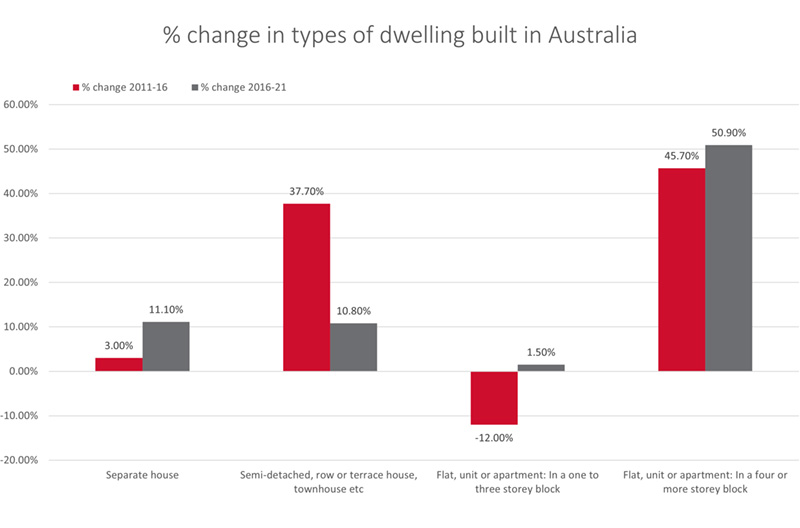Changing dynamics of Australian households shaping property landscape
Australia's evolving household composition is driving changes in the types of buildings and design features of homes in all parts of the country.
Changes in the composition and characteristics of Australian households over the past decade are altering the design and types of buildings being constructed.
As the population and construction sectors respond to influencing factors such as the remnant effects of the Global Financial Crash (GFC) or the pandemic, data from the Australian Bureau of Statistics’ recent census reflect a nation with new expectations for how and where they live.
On Census night, 2021, there were 10,852,208 private dwellings counted. Seventy per cent were detached houses, 13 per cent were townhouses and 16 per cent apartments.
Two thirds of households (66 per cent) owned their home outright or with a mortgage while one third of households rent (30.6 per cent).
There were 1,043,776 unoccupied dwellings on that night.
The Big Shift
The Census highlights notable shifts in the number of group households, lone person households, ‘couple family with no children’ and ‘one parent family’ households.
Between 2016-2021, group households increased by 10.6 per cent, up from 4.1 per cent of all households, to 4.3 per cent, however in 2021, the proportion of group houses fell to 3.9 per cent of all households.

Dr Michael Fotheringham, Managing Director, Australian Housing and Urban Research Institute.
In its analysis of the ABS data, the Australian Housing and Urban Research Institute (AHURI) research suggests the decline of group households reflect the direct impact of COVID in 2020.
“Certainly, Covid changed the way people think about their housing and what they look for in their housing,” Australian Housing and Urban Research Institute’s Managing Director, Dr Michael Fotheringham, told Australian Property Investor Magazine.
“The lockdown period when people were working from home meant people had to share the space, in the sense that it was a place where you live and a place where you work.
“That impacted on the built form preference people had, so where a family might have been perfectly happy with a scarcely used study nook that was a small alcove in a hallway or under a stairwell, which doesn’t quite cut it working from home.
“Some of that led to people wanting larger properties and resulted in people thinking about tree or sea changes, relocating from cities to regional areas where there’s perhaps more land available.
“There was a bit of a push for people to move into apartments as well, away from share houses because of communicable disease type concerns, particularly during the lockdown periods, plus the impact on casual employment particularly, which led to quite a lot of young people moving back to the family home.”
Multigenerational households
This trend for multigenerational households was already on the rise pre-Covid, but the pandemic prompted a surge.

Ashley Fell, Director of Advisory, McCrindle
Ashley Fell, Director of Advisory, at social research, demographics and data analytics agency McCrindle said living in a multigenerational household has not historically been ‘the Australian way’, but the census tells two stories about increasingly diverse communities of immigrants from countries who do traditionally live in multigenerational homes, and the critical issue of affordability.
“For our previous generation it was expected that you would be flying the nest maybe by your mid to late 20s,” Ms Fell said.
“Today, we’ve got a generation who are delaying having children, getting married, there’s the cost of living, the disparity between house prices and wages growth, so all of those factors do lend themselves to that.
“We have a bit of joke about Millennials, that they are a generation of ‘kippers’ (Kids in Parents Pockets Eroding Retirement Savings).
“They are eroding retirement savings, they are drawing on the bank of Mum and Dad a little bit more, and asking for a leg up and many parents are willing to help, perhaps not financially, but by being guarantors and things like that, and they let the kids stay at home a bit later in life where we do get more generations mixing.”
“What we need from our homes is changing in terms of work from home, flexible working, multiple people in the home, so you might have children doing education from home, people working from home, so that open plan is perhaps ready for a shift where we need more closed spaces for the purpose of our homes.”
Urban density
Heralding a trend for smaller homes are census figures showing the number of lone person households edged up from 24.4 per cent of all households in 2016 to 25.6 per cent in 2021.
Households comprising ‘Couple family with no children’ increased 13.2 per cent and single parent families - 1,068,268 on census night - showed a slow increase from 14.5 per cent of all households in 1996 to nearly 16 per cent in 2021.
The number of two-storey semi-detached houses and townhouses increased between 2016-2021 (17.5 per cent).
The proportion of apartments continues to increase, with apartments accounting for nearly one third (30.9 per cent) of the increase in private dwellings since 2016.
New separate detached house builds recorded an 11.1 per cent spike between 2016 and 2021 (668,794 houses up from 177,214 houses between 2011- 2016.

“There is a slight chicken and egg thing going on here,” University of Sydney senior lecturer in Urbanism, Dr Laurence Troy said.
“In a general sense, the more one bed apartments you build, the more, lone person households you are likely to get.
“However, the rising dominance of investors in Australian housing has fuelled the so-called ‘investor grade’ two bed apartment product, so my argument would be that in Sydney at least, over the past decade or more, the majority of new build dwellings are not being built with occupiers in mind, they are being built for investors.

Dr Laurence Troy, Senior Lecturer in Urbanism, The University of Sydney.
“Houses on the other hand, which still dominate in other parts of Australia, are driven much more by an owner-occupier market.
“There is some nuance here, but these have been the broad trends.
“The biggest factor at play is the availability of money, and to who.
“As the investor-driven demand really geared up post-GFC, this drove both the production and affordability pressures in places like Sydney,” he said.
Foreign investment, rock bottom interest rates, volume of capital available to spend in the housing market driving asset price inflation fuelled price jumps in favour of some people.
“At the bottom end, this has a direct impact on homelessness and overcrowding and an increasing rump of would-be homeowners that are stuck in private rental, adding competition to that space,” Dr Troy said.
Recent McCrindle research suggests the great Australian dream of home ownership is still alive and well for young people.
“It’s moving away from the notion of a detached home with a backyard however, to maybe an apartment or rentvesting, so there’s creative solutions around affordability, but property and getting into the market is still high on the agenda for emerging generations,” Ms Fell said.




















